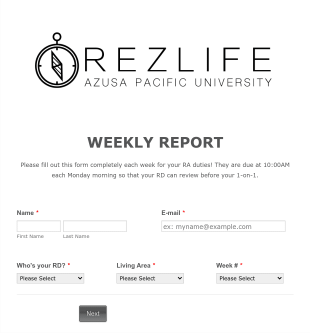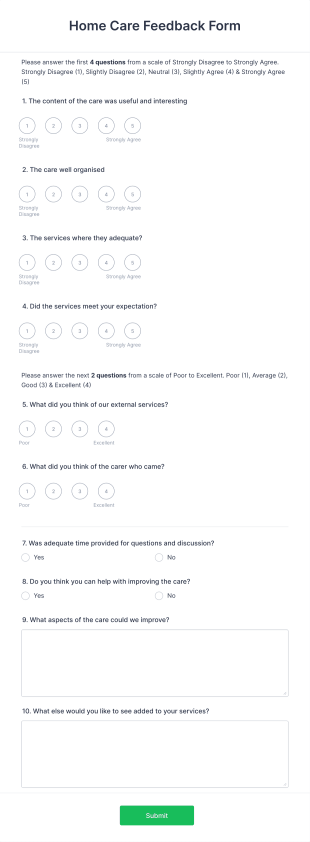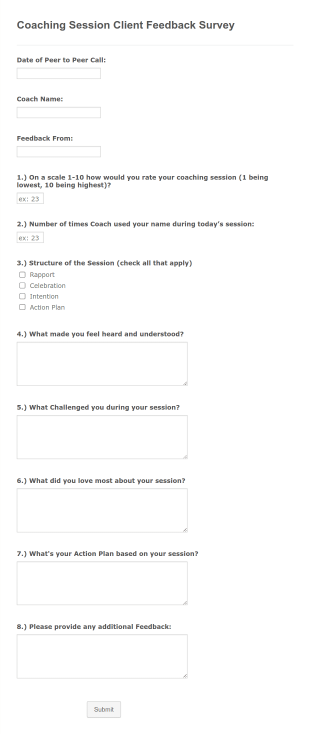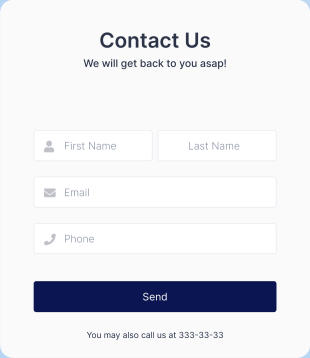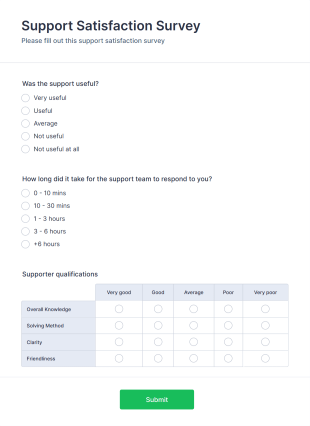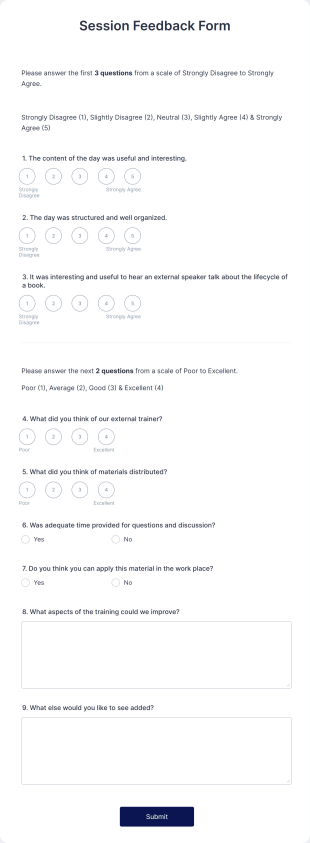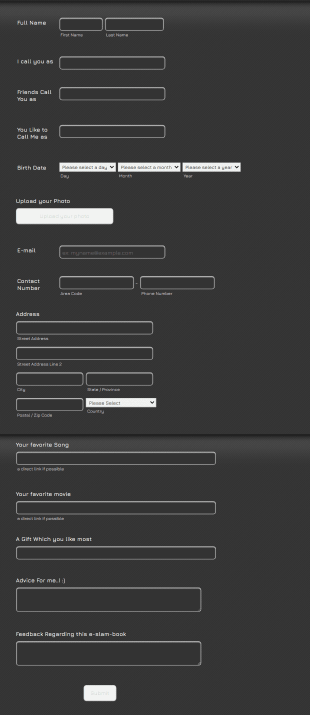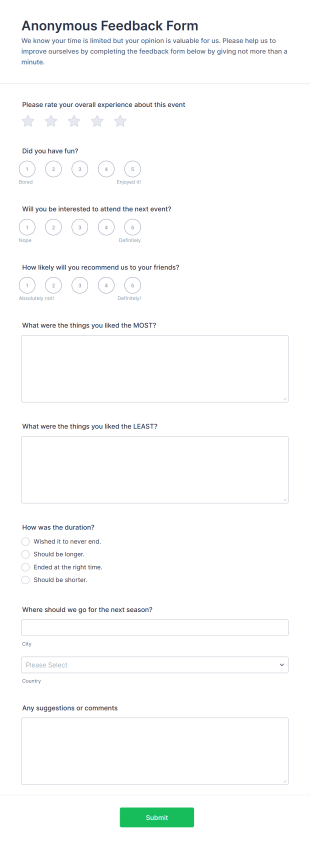Successful organizations depend on feedback, whether it comes from customers, the public, your own employees or your events. Thanks to feedback forms, you can gather information and use it to build a better working environment, increase the efficiency of your company, and provide more valuable service. To ensure that you're getting proper feedback, you need a feedback form template that captures all relevant information. With a robust collection of feedback templates, you can either choose from one of our collection of feedback form samples or start with a basic feedback form. Using the Jotform form builder you can then format and fully customize your own feedback form. Try one of our free online feedback form templates today!
Other Feedback Forms
1) What is a feedback form?
A feedback form is a tool that gives customers, employees, or even the public the opportunity to offer suggestions, complaints, or comments on an organization’s products and services.
These forms are popular across all industries — and for good reason. Since feedback is such a vital part of running and improving a business, it’s important to make sure your forms capture the right information and offer your business the maximum benefit possible.
2) What information should be included in a feedback form?
Feedback forms are so versatile that it’s difficult to identify any one element to include across the board. However, there are a few best practices you should consider while creating your form:
- Don’t make fields required.
- Allow respondents to provide open-ended comments.
- Keep your form straightforward and simple.
- Avoid yes/no questions.
- Tailor questions to fit your goals.
Avoid asking generic questions so that you get more actionable data and keep your respondents engaged. Offering an easy-to-use, anonymous questionnaire not only benefits your organization, but it also helps your respondents feel comfortable providing honest feedback.
3) What are the subtypes of feedback forms?
You can customize any feedback form to fit your needs. However, there are a number of common feedback form types that most industries use. Here are a few of them:
- Peer
- Parent
- Travel
- Patient
- Teacher
- Real estate
- Service
- Event
- Employee
- Presentation
- Customer service/satisfaction
No matter what type of form you need, Jotform likely has a feedback form template that fits your purposes. With more than 400 templates to choose from, Jotform is ready to help you gather feedback quickly and efficiently. And if you can’t find the form you need, you can easily build your own with Jotform and save it as a template for future use.
4) Who should use feedback forms?
Any organization can benefit from feedback forms by gathering important data and getting useful insights. Feedback forms are often used by
- HR departments
- Small businesses
- Large organizations
- Customer service leaders
- Employees
- Software developers
- Schools
- Doctors
- Event planners
Regardless of your industry, your organization will benefit from feedback forms. Having access to a library of more than 400 feedback form templates with Jotform increases these benefits by saving you time, money, and effort in the creation process.
5) What are the benefits of using a feedback form?
Feedback forms are essential to the continuous improvement of business practices. Without understanding how your organization affects its clientele and employees, you have no way of knowing if you’re truly meeting your goals and your customers’ needs. These forms offer your organization a number of significant benefits, including the opportunity to
- Improve products and services
- Update processes
- Understand customer needs
- Identify potential pain points
- Build customer loyalty
- Optimize your work environment
- Increase employee engagement
- Boost efficiency
Properly implementing and analyzing customer and employee feedback forms will supercharge your organization. By eliminating pain points and improving the customer experience, you’ll stay ahead of the competition and build a better experience for your customers and employees alike.
6) What are the typical use cases of feedback forms?
Organizations use feedback forms for various purposes, and the information they gather can deliver significant benefits. Some common use case examples include
- Employee feedback
- Customer loyalty feedback
- Event experience feedback
- Patient feedback
- Product or service feedback
- User experience feedback
The key to getting the most out of your feedback forms is to tailor them to fit your exact needs. Relying on generic feedback forms will likely yield equally generic feedback.
7) How do I create a feedback form?
How you build a feedback form depends on your resources and the purpose of the form. To build a feedback form from scratch using Jotform, follow these steps:
- Go to the Jotform Form Builder.
- Name your feedback form and update your header with your logo or other branding elements.
- On the left, click the Add Form Element (+) button to search for form fields.
- To add your form fields, just drag and drop them onto your form.
- Select the Form Designer button (the paint roller icon) on the right to customize your form’s design.
- Once you’re done, use the Publish button at the top right to share it with your desired recipients in the way that best suits your needs.
Don’t have time to create a new form? Jotform has more than 400 feedback form templates to choose from. Find a template that best fits your purposes and update the visuals, body copy, and headings accordingly.
8) How do I customize a feedback form template?
Templates are a helpful resource that will save you time and effort, especially if you need to create forms quickly or for many uses. With more than 400 feedback form templates available, Jotform makes finding and customizing templates easy.
To customize a template in Jotform, choose one from the template library, then click the Use Template button. This will allow you to update your template to match your brand and purpose. By customizing a template instead of building a form from scratch, you’ll avoid the time-consuming design and building process — so you can get started gathering feedback even faster.
If you want to use an existing form you’ve relied on for years, Jotform can help with that, too. Simply upload the form using Jotform’s PDF Editor to customize your visuals, add form fields, and send it via email or link. Embed your form on your website, use forms offline, and manage submissions — all through Jotform’s powerful suite of tools.

